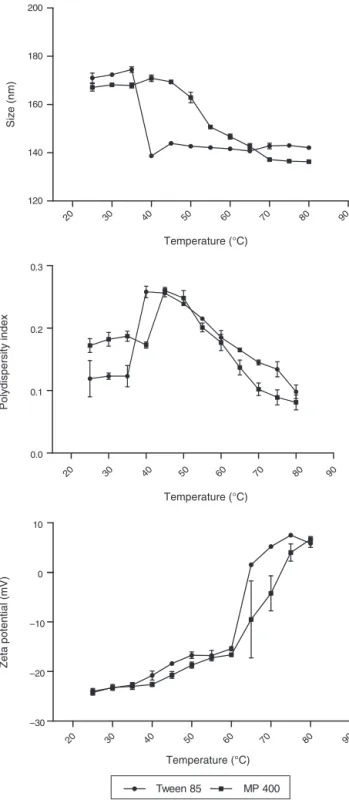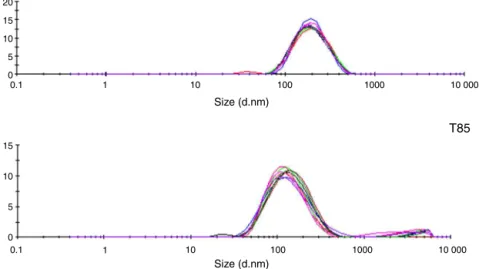w ww . e l s e v i e r . c o m / l o c a t e / b j p
Short
communication
Utilization
of
dynamic
light
scattering
to
evaluate
Pterodon
emarginatus
oleoresin-based
nanoemulsion
formation
by
non-heating
and
solvent-free
method
Anna
E.M.F.M.
Oliveira
a,b,
Jonatas
L.
Duarte
a,b,
Rodrigo
A.S.
Cruz
a,b,
Edemilson
C.
da
Conceic¸
ão
c,
José
C.T.
Carvalho
a,b,
Caio
P.
Fernandes
a,b,∗aLaboratóriodePesquisaemFármacos,UniversidadeFederaldoAmapá,Macapá,AP,Brazil
bLaboratóriodeNanobiotecnologiaFitofarmacêutica,UniversidadeFederaldoAmapá,Macapá,AP,Brazil
cLaboratóriodePesquisa,DesenvolvimentoeInovac¸ãoemBioprodutos,UniversidadeFederaldeGoiás,Goiânia,GO,Brazil
a
r
t
i
c
l
e
i
n
f
o
Articlehistory:
Received30June2016
Accepted22November2016
Availableonline9February2017
Keywords:
Lowenergymethod
Sucupira-branca
Colloidalsystem
Vouacapanditerpenes
Sesquiterpenes
Phytopharmaceuticalnanobiotechnology
a
b
s
t
r
a
c
t
PterodonemarginatusVogel,Fabaceae,isagreatsourceofbioactivecompounds.Themostknownand studiedherbalderivativefromthisspeciesisanambar-coloredoleoresinthatcontainsvouacapane diterpenesandvolatileterpenoids,suchas-caryophyllene.Somerecentpapersaimedtogenerate nanoemulsionsusingthisoleoresinforbiologicalapplications.However,theyusedhigh-energy meth-odsthatelevatecostsoftheprocessorheatingprocedures,whichofferthedisadvantageofpossible volatilesubstancesloss.Thus,aspartofourongoingstudieswithnanobiotechnologyofnatural prod-ucts,especiallyregardingpreparationofnanoemulsionswithpromisingplant-basedoilsbylowcost andlowenergymethods,wedecidedtoevaluatetheabilityofnon-heatingandsolvent-freemethodto generateP.emarginatusoleoresin-basednanoemulsions.Twonon-ionicsurfactantswereusedto gen-eratethenanoemulsionsbyasimplehomogenizationmethodwithvortexstirrer.Lowmeandroplet size(<180nm)andlowpolydispersityindex(<0.200)wereobservedevenafteronedayofpreparation. Thelowcoefficientofvariationfortheanalyzedparametersofdifferentbatchesandsimilarprofilefor dropletsizedistributionsuggestedreproducibilityofthemethod.After30days,somedegreeofdroplet growthwasobservedonnanoemulsionpreparedwithpolyethyleneglycol400monooleate,whilealmost noalterationwasobservedfornanoemulsionpreparedwithpolysorbate85.Programmedtemperature rampanalysisrevealedthatnomajoreffectsondropletsizeandpolydispersityindexwereobserved, suggestingtherobustnessofformednanoemulsions.Thus,thepresentstudyshowsforthefirsttimethe formationofsucupira-basednanoemulsionsbyasimple,lowcostandecofriendlymethod.Thisstudy opensnewperspectivesforbioactiveevaluationofthisnovelnano-product.
©2017SociedadeBrasileiradeFarmacognosia.PublishedbyElsevierEditoraLtda.Thisisanopen accessarticleundertheCCBY-NC-NDlicense(http://creativecommons.org/licenses/by-nc-nd/4.0/).
Introduction
PterodonemarginatusVogelbelongstothefamilyFabaceaeand
it is widespread in Midwest regionof Brazil,being also found
in South-Eastern,Northeastand North regions (Lima andLima,
2016).Its fruits, as well as those fromother Pterodon species,
arecommonlyknownassucupira-branca.Thisplantpartisused
forextractionofanoleoresinthathasvouacapanditerpenesand
sesquiterpenes.Sucupira-brancaoleoresinhasseveralbiological
properties, including analgesic,antiinflammatory, antinoceptive
∗ Correspondingauthor.
E-mail:caiofernandes@unifap.br(C.P.Fernandes).
andlarvicidalactivities(Hansenetal.,2010;HoscheidandCardoso,
2015).
Natural products from plant origin have been subjected to
severalstudiesaimingto generatenovelnanotechnology-based
bioactive systems.Regarding severaltypes of nano-size
formu-lations,herbaloils(includingoleoresins)areveryinterestingfor
nanoemulsionpreparation(Zorzietal.,2015).Nanoemulsionsare
kineticstabledispersesystemsconstitutedbytwoimmiscible
liq-uids, oftenstabilized by surfactant (s).The dropletdiameter is
onthenanometerrange, oftenrangingfrom20nm todifferent
upperlimits(e.g.500,300,200and100nm),thatvaries
accord-ingtoauthorcriteria(SolansandSolé,2012).High-energymethods
involvedonnanoemulsionformationoftenmakeuseofhighenergy
devices thatelevate costsoftheprocess,suchashighpressure
homogenizers or ultrasonicators. Spontaneous energy methods
http://dx.doi.org/10.1016/j.bjp.2016.11.005
0102-695X/©2017SociedadeBrasileiradeFarmacognosia.PublishedbyElsevierEditoraLtda.ThisisanopenaccessarticleundertheCCBY-NC-NDlicense(http://
involveutilizationofvolatileorganicsolventsthatmaynotbe
con-sideredecofriendly,consideringtheirpotentialtoxicity.Moreover,
itisnecessarytoremovethiscomponentofthenanoemulsification
process. Low-energy methods make use of intrinsic
character-istics of the system,often involving phase inversion (Sugumar
etal.,2016).Mostcommonphaseinversionmethodsare
associ-atedtophasetransitionsinducedbychangeintemperature(phase
inversiontemperature–PIT)orcomposition(phaseinversion
com-position–PIC)(SolansandSolé,2012).
Growinginterest is observed for nanobiotechnology studies
witholeoresinfromsucupira-branca(Hoscheidetal.,2015;Pascoa
etal., 2015; Oliveiraet al., 2016).The oleoresinobtainedfrom
thefruitsof P.emarginatusthat wasusedin thepresent study
have been previously submitted to chemical characterization.
ChromatographicanalysiscarriedoutusingHPLC-DADand
com-parison to authentic external standards revealed the presence
ofmethyl6␣,7-dihydroxyvouacapan-17--oate,geranylgeraniol
and-caryophyllene,beinginaccordancewithphytochemical
pro-fileofthegenus(Oliveiraetal.,2016).Thus,itisworthmentioning
thatutilizationofaphaseinversiontemperaturemayleadsome
lostofvolatiles,even ifit isabletogeneratefinedroplets. The
presentstudyaimstoinvestigatethepossibilityofgeneratingP.
emarginatusoilinwaternanoemulsionsusingasimplelowenergy,
non-heatingandsolvent-freeapproachthatcanbeconsideredvery
promising for development of viable, low cost and ecofriendly
nanoproductswiththisnaturalrawmaterial.
Materialandmethods
PterodonemarginatusVogel,Fabaceae,fruitswereobtainedat
theCentralMarketofGoiânia,GO,Brazil,andwereidentifiedby
Dr. José Realinode Paula. Voucher specimen was deposited at
theHerbariumofGoiásFederalUniversity(GO,Brazil)underthe
register number 41714. The oleoresin waspreviously obtained
fromfruits by cold pressing, beingstored in amberglass flask
andkeptat−20◦C(Oliveiraetal.,2016).Priortoutilization,the
oleoresinwasleft underroomtemperaturefortwo daysand it
wascentrifugedtoremovenon-solublecompounds.Oilinwater
nanoemulsionswereprepared byblending non-ionicsurfactant
(polysorbate85,Sigma–Aldrich,StLouis,MO,or
polyethylenegly-col400monooleate,Praid,SP,Brazil)andP.emarginatusoleoresin
atafixedsurfactanttooilratio(9:1).Aftercomplete
homogeniza-tionoftheoilyphase(surfactant+oleoresin),distilledwaterwas
slowlyaddeddropwisetothis mixtureundervigorousagitation
usingavortexstirrer.Eachemulsionpresentedfinalmassof10g
and90%(w/w)ofwater.Dynamiclightscattering(DLS)analysiswas
carriedoutusingaZetasizerNanoZS,Malvern,UK)equippedwith
a10mW“red”laser(=632.8nm)andsamplesweremeasuredata
90◦scatteringdetectorangleforsizemeasurements.Theeffectsof
dilutiononmeandropletsize,polydispersityindex(pdi)andzeta
potentialwereperformedusingdifferentdilutionsfactors(1:10,
1:25,1:50and 1:100).Reproducibilityofthenanoemulsion
for-mationwascarriedoutbypreparatingofthreedifferentbatchesof
thenanoemulsions.Nanoemulsionswerealsosubjectedtoanalysis
usingaprogrammedlinearrampoftemperaturestartingfrom25◦C
to80◦Cat5◦Cintervals.Resultsareexpressedasmean±standard
deviation.
Resultsanddiscussion
Pterodonemarginatusoleoresin-basednanoemulsionsprepared
withpolysorbate85 orpolyethyleneglycol400monooleate
pre-sented a fine aspectwith bluish reflect (Fig.1A and B) that is
characteristicforthistypeofcolloidalsystem.Basedonour
ongo-ingstudieswithnaturaloilsandoleoresins,wehaveobservedthat
Fig.1. NanoemulsionspreparedwitholeoresinextractedfromPterodon
emargina-tusfruitsandnon-ionicsurfactantsatday0:(A)polyethyleneglycol400monooleate
or(B)polysorbate85andday30:(C)polyethyleneglycol400monooleateor(D)
polysorbate85.
itiseasiertoformoilinwaternanoemulsionsusingasystem
con-stitutedbylargeamountsofwater(90–95%).Moreover,itiswell
establishedthatincreasingsurfactanttooilratiooftenenhances
kineticstabilitybyreducingthedropletsize(Ostertagetal.,2012;
KomaikoandMcClements,2015).Sinceweaimedtoevaluateifitis
possibletogeneratenanoemulsionsusinglowenergy,non-heating
andsolvent-freemethod,weoptedtousethisratioasabackground
composition.
Severaldilutionswereperformedjust afterwardsthe
prepa-ration of P. emarginatus oleoresin-based nanoemulsions with
polysorbate85 orpolyethyleneglycol400monooleate(Table1).
Higher mean droplet size and polydispersity index (pdi) were
observed at the dilution ratio of 1:10, for nanoemulsions
pre-pared with both surfactants, which also presented lower zeta
potential (in module). On another hand, no major differences
wereobservedfor meandropletsizeontheremainingdilution
ratios(1:25, 1:50and 1:100),which were around 160–170nm
forbothnanoemulsions.Slightlylowerpolydispersityindexwas
observedfornanoemulsionpreparedwithpolysorbate85,which
wasaround0.111–0.122,whilepdiofdropletsfromnanoemulsion
preparedwithpolyethyleneglycol400monooleatewerearound
0.149–1.152.Zetapotentialofthesenanoemulsionsrangedfrom
−21.9±0.5mV (dilution ratio 1:25 for nanoemulsion prepared
withpolysorbate85)to−28.7±0.7mV(dilutionratioof1:100of
Table1
Effectofdilutionondropletsize,polydispersityindex(pdi)andzetapotentialofnanoemulsionspreparedwitholeoresinextractedfromPterodonemarginatusfruitsand
non-ionicsurfactants(polyethyleneglycol400monooleateorpolysorbate85).Eachmeasurementrepresentsmean±standarddeviation.Eachanalysiswasperformedin
triplicate.
Dilution Polysorbate85 Polyethyleneglycol400monooleate Size(nm) Pdi Zeta(mV) Size(nm) Pdi Zeta(mV) 1:10 224.6±0.6 0.265±0.008 −16.1±0.3 176.5±1.8 0.188±0.014 −20.1±0.4 1:25 166.7±1.8 0.113±0.011 −21.9±0.5 167.0±1.9 0.149±0.005 −25.2±0.8 1:50 164.4±0.5 0.122±0.001 −24.9±0.1 160.8±0.2 0.152±0.021 −23.3±0.3 1:100 163.5±0.2 0.111±0.015 −26.2±1.2 159.2±0.9 0.150±0.006 −28.7±0.7
Dilutionpriortodropletsizedistributionanalysisisconsidereda criticalparameterandoptimizeddilutionfactorshouldbe deter-mined,in order toavoid multiplescattering effects. Moreover, dilutionofpreviouslypreparednanoemulsionshasbeen consid-ered an important parameter that affects stability and droplet growthofnanoemulsions(Saberietal.,2013a,b,2014).Considering
thatmoreconcentratedstocknanoemulsionshouldbepreferred
for further dilutions in practical applicable productsand since
nomajordifferencewasobservedformostofthem,wedecided
tofurtherinvestigateeffectofstorageortemperatureusingthe
nanoemulsionat1:25dilution.
After 30 days of storage, the nanoemulsion prepared with
polyethyleneglycol 400 monooleate (1:25 dilution factor)
pre-sentedaslightcreaming(Fig.1C),whilethenanoemulsionprepared
withpolysorbate85(1:25dilutionfactor)maintainedthevisual
appearance (Fig. 1D). It was observed that mean droplet size
and polydispersity index of the nanoemulsion prepared with
polyethyleneglycol 400 monooleate presented major increase
(Fig.2AandB).Onanotherhand,lowerincreasedonmeandroplet
size(181.5±0.9nm)andpolydispersityindex(0.111±0.012)was
observedfornanoemulsionpreparedwithpolysorbate85,
show-ingasimilarprofileofdropletsizedistribution,whencomparedto
day0(Fig.2CandD).Thesurfactanttypeisamajorparameteron
nanoemulsionformationandstabilization.Onthiscontext,
inves-tigationsregarding surfactant concentrationarevery important
fordevelopmentofoptimalnanoemulsions(Guttoffetal.,2015).
Consideringthatweoptedonthisstudyforafixedsurfactanttooil
ratio,itisworthmentioningthatdifferencesbetweenthe
surfac-tantsmayberesponsiblebydifferencesondropletsizegrowthand
nanoemulsionstabilization.
Fig.3showstheinfluenceoftemperatureondropletsize
dis-tribution and zeta potential. Analysis of mean droplet size of
nanoemulsionpreparedwithpolysorbate85asfunctionof
tem-perature revealedthat it remained almostconstant from25 to
35◦C (around170nm).Then, itrapidlydecreased, beingaround
140nm from 40 to 80◦C. On another hand, droplet diameter
reduction whichwasobservedfornanoemulsionpreparedwith
polyethyleneglycol400monooleateoccurredmoregradually,also
reachinglowvaluesathighertemperatures.Probablythecoating
filmthatthissurfactantformthroughthedropletsismorerigid
duetotheplasticizercharacterofpolyethyleneglycolsurfactants.
Thus,rearrangementoftheinternalphasemaynotbesodrastic
asitwasobservedforpolysorbate85.Polydispersityindexofboth
nanoemulsionsstartedbelow0.200,beingthevalueassociatedto
nanoemulsionpreparedwithpolysorbate85slightlylowerthanthe
valueobservedfornanoemulsionpreparedwith
polyethylenegly-col400monooleate.Then,theyreachedamaximumaround0.250
after35◦Canddecreasedtominimumvaluesbelow0.100at80◦C.
Zetapotentialslightchangedbelow40◦C,however,overallgradual
increasewasobservedasfunctionoftemperature.
Non-ionic surfactants stabilizes nanoemulsions by reducing
interfacialtensionandtheyalsoformalayerthatpromotessteric
repulsionbetweendroplets(Wangetal.,2009).Themain
mech-anismfornanoemulsiondestabilizationisassociatedtoOstwald
ripening,whichinducesformationoflargerdroplets(Solansand
Solé, 2012). Interestingly, increased temperatures induced
for-mation ofsmaller droplets whileno increase onpolydispersity
indexwasobservedabove0.300.Moreover,pdivaluesreturned
tobasalvaluesaround0.100.Thisparameterreflectshomogeneity
ofdropletsizedistributionandgradualformationoflargerdroplets
fromastartingmonomodaldistributionwouldresultonincreased
polydispersityindex.
Migration of acid compounds from copaiba oleoresin was
associatedtonegativezetapotentialvaluesonnanoemulsions
pre-paredwiththismaterial(Diasetal.,2014).Vouacapanditerpenes,
includingsomecompoundswithacidmoiety, arecharacteristic
ofsucupiraoleoresinandmayexplainthesestartingzeta
poten-tial values. Further increase of temperature may have induced
growingpartitionofadditionalsubstancesthatdonoteasily
disso-ciate,thereforereducingthiszetapotential.Moreover,deposition
20
15
10
5
0
0.1 1 10 100 1000 10 000
20
15
10
5
0
Size (d.nm) Size (d.nm)
0.1 1 10 100 1000 10 000
20
15
10
5
0 15
10
5
0
Size (d.nm)
0.1 1 10 100 1000 10 000
Size (d.nm)
0.1 1 10 100 1000 10 000
A
B
C
D
Fig.2.DropletsizedistributionofnanoemulsionspreparedwitholeoresinextractedfromPterodonemarginatusfruitsandpolyethyleneglycol400monooleateat(A)day
20 30 40 50 60 70 80 90 120
140 160 180 200
Temperature (°C)
20 30 40 50 60 70 80 90
Temperature (°C)
20 30 40 50 60 70 80 90
Temperature (°C)
Size (nm)
0.0 0.1 0.2 0.3
Polydispersity index
–30 –20 –10 0 10
Tween 85 MP 400
Zeta potential (mV)
Fig.3.Influenceoftemperatureondropletsize,polydispersityindex(pdi)and
zetapotentialofnanoemulsionspreparedwitholeoresinextractedfromPterodon
emarginatusfruitsandnon-ionicsurfactants(polyethyleneglycol400monooleate
orpolysorbate85).Eachmeasurementrepresentsmean±standarddeviation.Each
analysiswasperformedintriplicate.
ofsomesubstancesontheinterfacemayformmorecompactfilms
andtherefore,enhancingthestabilityofthesystem(Wangetal.,
2009).
Wedecidedtoinvestigatethereproducibilityofthemethod
on nanoemulsion formation and low coefficient of variation
values of three individual batches were observed for droplet
size (CVMP400=0.00499; CVT85=0.0113), pdi (CVMP400=0.0534;
CVT85=0.0732) and zeta potential (CVMP400=0.0416;
CVT85=0.0741). Fig. 4 reflects the technical feasibility of the
methodtoinduceformationofnanoemulsionswithlowdroplet
sizeand lowpolydispersity index(<0.300),beingin accordance
with satisfactory results for size distribution of aqueous
nan-odispersions (Tan et al., 2016). A study aiming to optimize
thepreparation of nanoemulsions with copaiba oleoresinfrom
Copaiferamultijuga,whichbelongs tothesamebotanicalfamily
(Fabaceae)ofP.emarginatus,performedatriplicateofcenterpoint
fromafactorialdesignexperimentandalsoobservedlow
coeffi-cientofvariationforanalyzedparameters(Diasetal.,2014).Thus,
overallourresultssuggestthereproducibilityofthemethodfor
thepreparationofnanoemulsionsusingP.emarginatusoleoresin
withahighprevalenceofdropletsbelow200nm.
Dropletsizedistributionofnanoemulsionsfromthethree
dif-ferentbatchesalsorevealalessabundantdropletpopulationbelow
100nm, for those prepared withboth surfactants. Moreover, a
dropletpopulationwithsizeabove1000nm(microdroplets)was
observedonnanoemulsionpreparedwithpolysorbate85.Sincethe
firststudieswithP.emarginatusoleoresin,it wasobservedthat
diterpenesgradually precipitate onthis viscousoily raw
mate-rial(MahajanandMonteiro,1973).Consideringthehighviscosity
of theP.emarginatus oleoresin,somemicroparticles (or
micro-crystals) of the diterpenes on suspension may remain on the
supernatant that wasused for nanoemulsification,even after a
centrifugingstep,beingresponsiblebythismicro-sizepopulation.
Furtherstudiesaimingtobetterinvestigatethishypothesisor
con-comitantformation ofanother systems(e.g. multiphaseregion,
microdroplets/coarsedroplets)arerequiredtosolvethese
ques-tions.
Alarvicidalnanoemulsionpreparedwiththesameoleoresin
thatwasusedinthepresentstudy,amixtureofpolysorbate
80/sor-bitanmonooleate(HLBmixture=11)and waterpresented mean
droplet sizearound 130nm, polydispersity index around 0.200
andzetapotentialaround−30mV.Thenanoemulsificationmethod
involvedhomogenizationofoilyphase(P.emarginatusoleoresin
andsurfactants)at80◦Cfor30min(Oliveiraetal.,2016).A
pro-cedurethatalsoinvolvedheatingprocesswasperformedaiming
toprepareP.emarginatusbasednanoemulsionsduetothe
antiin-flammatorypotential(Pascoaetal.,2015).Itisworthmentioning
thatvolatilesubstancesfromtheoleoresinmaybelostduringheat
oftheoilyphase.Forthisreason,utilizationofeffective
nanoemul-sificationmethodsthat donotinvolvea heatingstepshouldbe
consideredanadvantage,consideringthattheywouldprotectthe
undesiredlossofvolatiles,includingsometerpenoids.
Rosmarinusofficinalisessentialoilwasformerlyusedfor
devel-opmentof anoilin waternanoemulsionusing phase inversion
temperature (PIT) method and droplets with mean diameter
around 100nm were obtained (Fernandes et al., 2013). Latter,
nanoemulsion phase inversion method using a titration
pro-cesswasperformedforachievementofbioactiverosemary-based
nanoemulsionsusingthesamenaturalrawmaterial.Afterseven
daysofstorage,meandropletsizearound115.0nmandlow
poly-dispersityindex(<0.300)wereobserved(Duarteetal.,2015).
The nanoemulsions prepared with oleoresin from Copaifera
duckei were prepared by using phase inversion temperature
method.Lowmeandropletsize(145.2nm)andrelativelybroad
droplet size distribution (pdi=0.378) were observed for this
nanoproductafteronedayofpreparation(Rodriguesetal.,2014).
The oleoresin from another copaiba species (C. multijuga) was
nanoemulsifiedusingahigh-pressurehomogenizeranddroplets
sizearound120–140nmandzetapotentialaround−20mVwere
obtained (Dias et al., 2012). On another study, nanoemulsions
preparedwithC.multijugaoleoresinwerepreparedusing
high-pressurehomogenizationmethodorspontaneousemulsification
usingorganicsolvents.Mostofnanoemulsionspreparedbyhigh
energymethodpresentedmeandropletsizearound160–200nm
andmonomodaldistribution,beingconsideredmoreefficientthan
20
15
10
5
0
15
10
5
0
0.1 1 10 100 1000 10 000
0.1 1 10 100 1000 10 000
Size (d.nm)
MP400
T85
Size (d.nm)
Fig.4.DropletsizedistributionofPterodonemarginatusoleoresin-basednanoemulsionspreparedwithpolyethyleneglycol400monooleate(MP400)orpolysorbate85(T85).
Eachmeasurement(intriplicate)representsthreedifferentbatchesofnanoemulsions.
TheoleoresinfromP.pubescensmixedwithphospholipon90G
wasaddedthroughaqueousdispersionsofseveralsurfactantsand
thennanoemulsifiedusinghigh-speedshearhomogenizer.Mean
diameterofdropletsrangedfrom199to860nmandlowestsize
wereobservedfornanoemulsionspreparedwithpolyethylene
gly-col(PEG-40)castoroil/sorbitanoleateandPEG-40hydrogenated
castoroil/sorbitanoleate(PEG-40H)(Hoscheidetal.,2015).The
andiroba(Carapaguianensis)oilwassubjectedtonanoemulsion
preparationby aself-nanoemulsifyingmethodusingacetoneas
organicphaseconstituent.Onthissamestudy,anaroeira(Schinus
molle)-basednanoemulsionwasprepared usingahigh-pressure
homogenizer(Baldisseraetal.,2013).
Conclusion
The present study shows that it is possible to generate P.
emarginatus nanoemulsions by a non-heating and solvent free
approach,withoutusinghighenergyequipment.Thisecofriendly
concepthasmajoradvantagesduetopossiblereducingcostsand
even less impairment to environment and health. It is worth
mentioningthat furtherstudiesshouldbenecessarytodevelop
optimalP.emarginatusnanoemulsionsusingthismethod.
How-ever,webelievethatitopensgreatperspectivesforfastandsimple
preparationofnaturalproduct-basednanoemulsionsforbiological
evaluation,beingcomparableorevenpotentiallymoreeffective
thanmostusedmethods. It alsoprovidesgreat information for
studiesaimingtodevelopthistypeofcolloidalsystem,sincethis
informationarestillscarceforcomplexBraziliannaturaloils.
Authors’contributions
AEMFMO(PhDstudent),RASC(PhDstudent)andJLD
(under-graduate student) contributed running the laboratory work,
analysisof the data and draftedthe paper. ECCcontributed to
oleoresinextraction,characterization andcriticalreading ofthe
manuscript.JCTCandCPFdesignedthestudy,supervisedthe
labo-ratoryworkandcontributedtocriticalreadingofthemanuscript.
Alltheauthorshavereadthefinalmanuscriptandapprovedthe
submission.
Conflictsofinterest
Theauthorsdeclarenoconflictsofinterest.
Acknowledgments
The authors thank CNPq (Rede Amazônica de Pesquisa em
Biofármacos–407768/2013-0),Fapeap(Prodetec Araguari–
Pro-cess n◦ 250.203.035/2013) and PROPESPG (PROPUBLIC and
PAPESQ)forfinancialsupport.
References
Baldissera,M.D.,daSilva,A.S.,Oliveira,C.B.,Zimmermann,C.E.P.,Vaucher,R.A.,
Santos,R.C.V.,Rech,V.C.,Tonin,A.A.,Giongo,J.L.,Mattos,C.B.,Koester,L.,
San-turio,J.M.,Monteiro,S.G.,2013.Trypanocidalactivityoftheessentialoilsin
theirconventionalandnanoemulsionforms:invitrotests.Exp.Parasitol.134, 356–361.
Dias,D.O.,Colombo,M.,Kelmann,R.G.,Souza,T.P.,Bassani,V.L.,Teixeira,H.F.,Veiga
Jr.,V.F.,Limberger,R.P.,Koester,L.S.,2012.Optimizationofheadspace
solid-phasemicroextractionforanalysisof-caryophylleneinananoemulsiondosage formpreparedwithcopaiba(CopaiferamultijugaHayne)oil.Anal.Chim.Acta 721,79–84.
Dias,D.O.,Colombo,M.,Kelmann,R.G.,Kaiser,S.,Lucca,L.G.,Teixeira,H.F.,
Lim-berger,R.P.,VeigaJr.,V.F.,Koester,L.S.,2014.OptimizationofCopaibaoil-based
nanoemulsionsobtainedbydifferentpreparationmethods.Ind.Crop.Prod.59, 154–162.
Duarte,J.L.,Amado,J.R.R.,Oliveira,A.E.M.F.M.,Cruz,R.A.S.,Ferreira,A.M.,Souto,
R.N.P.,Falcão,D.Q.,Carvalho,J.C.T.,Fernandes,C.P.,2015.Evaluationof
larvi-cidalactivityofananoemulsionofRosmarinusofficinalisessentialoil.Rev.Bras. Farmacogn.25,189–192.
Fernandes, C.P.,Mascarenhas, M.P., Zibetti, F.M., Lima, B.G., Oliveira, R.P.R.F.,
Rocha, L.,Falcão, D.Q., 2013. HLB value, an important parameter forthe
developmentofessentialoilphytopharmaceuticals.Rev.Bras.Farmacogn.23, 108–114.
Guttoff, M., Saberi, A.H., McClements, D.J., 2015. Formation of vitamin D
nanoemulsion-baseddeliverysystemsbyspontaneousemulsification:factors affectingparticlesizeandstability.FoodChem.171,117–122.
Hansen,D.,Haraguchi,M.,Alonso,A.,2010.Pharmaceuticalpropertiesof“sucupira”
(Pterodonspp.).Braz.J.Pharm.Sci.46,607–616.
Hoscheid,J.,Cardoso,M.L.C.,2015.Sucupiraasapotentialplantforarthritis
treat-mentandotherdiseases.Arthritis,http://dx.doi.org/10.1155/2015/379459.
Hoscheid,J.,Outuki,P.P.,Kleinubing,S.A.,Silva,M.F.,Bruschi,M.L.,Cardoso,M.L.C.,
2015.DevelopmentandcharacterizationofPterodonpubescensoil
nanoemul-sionsasapossibledeliverysystemforthetreatmentofrheumatoidarthritis. ColloidsSurf.A:Physicochem.Eng.Asp.484,19–27.
Komaiko,J.,McClements,D.J.,2015.Low-energyformationofediblenanoemulsions
byspontaneousemulsification:factorsinfluencingparticlesize.J.FoodEng.146, 122–128.
Lima, H.C. de, Lima, I.B. Pterodon in Lista de Espécies da Flora do Brasil.
JardimBotânicodoRiodeJaneiro.Availableat:http://floradobrasil.jbrj.gov.br/
jabot/floradobrasil/FB29842(accessed28.06.16).
Mahajan,J.R.,Monteiro,M.B.,1973.NewditerpenoidsfromPterodonernarginatus
Vog.J.Chem.Soc.1,520–525.
Oliveira,A.E.M.F.M.,Duarte,J.L.,Amado,J.R.R.,Cruz,R.A.S.,Rocha,C.F.,Souto,R.N.P.,
Ferreira,R.M.A.,Santos,K.,Conceic¸ão,E.C.,Oliveira,L.A.R.,Kelecom,A.,
Fernan-des,C.P.,Carvalho,J.C.T.,2016.Developmentofalarvicidalnanoemulsionwith
Ostertag,F.,Weiss,J.,McClements,D.J.,2012. Low-energyformationofedible nanoemulsions:factorsinfluencingdropletsizeproducedbyemulsionphase inversion.J.ColloidInterfaceSci.388,95–102.
Pascoa,H.,Diniz,D.G.A.,Florentino,I.F.,Costa,E.A.,Bara,M.T.F.,2015.Microemulsion
basedonPterodonemarginatusoilanditsanti-inflammatorypotential.Braz.J. Pharm.Sci.51,117–126.
Rodrigues,E.C.R.,Ferreira,A.M.,Vilhena,J.C.E.,Almeida,F.B.,Cruz,R.A.S.,Florentino,
A.C.,Souto,R.N.P.,Carvalho,J.C.T.,Fernandes,C.P.,2014.Developmentofa
larvicidalnanoemulsionwithCopaiba(Copaiferaduckei)oleoresin.Rev.Bras. Farmacogn.24,699–705.
Saberi,A.H.,Fang,Y.,McClements,D.J.,2013a.Effectofglycerolonformation,
sta-bility,andpropertiesofvitamin-Eenrichednanoemulsionsproducedusing spontaneousemulsification.J.ColloidInterfaceSci.411,105–113.
Saberi,A.H.,Fang,Y.,McClements,D.J.,2013b.FabricationofvitaminE-enriched
nanoemulsionsbyspontaneousemulsification:effectofpropyleneglycoland ethanolonformation,stability,andproperties.FoodRes.Int.54,812–820.
Saberi,A.H.,Fang,Y.,McClements,D.J.,2014.StabilizationofvitaminE-enriched
mini-emulsions:influenceoforganicandaqueousphasecompositions.Colloids Surf.A:Physicochem.Eng.Asp.449,65–73.
Solans,C.,Solé,I.,2012.Nano-emulsions:formationbylow-energymethods.Curr.
Opin.ColloidInterfaceSci.17,246–254.
Sugumar,S.,Ghosh,V.,Mukherjee,A.,Chandrasekaran,N.,2016.Essentialoil-based
nanoemulsionformationbylow-andhigh-energymethodsandtheir
applica-tioninfoodpreservationagainstfoodspoilagemicroorganisms.InPreedy,V.R.
(org.)EssentialOilsinFoodPreservation,FlavorandSafety.AcademicPress,pp.
93–100.
Tan,T.B.,Yussof,N.S.,Abas,F.,Mirhosseini,H.,Nehdi,I.A.,Tan,C.P.,2016.
Form-ingaluteinnanodispersionviasolventdisplacementmethod:theeffectsof processingparametersandemulsifierswithdifferentstabilizingmechanisms. FoodChem.194,416–423.
Wang,L.,Dong,J.,Chen,J.,Eastoe,J.,Li,X.,2009.Designandoptimizationofa
newself-nanoemulsifyingdrugdeliverysystem.J.ColloidInterfaceSci.330, 443–448.
Zorzi,G.K., Carvalho,E.L.S.,vonPoser,G.L.,Teixeira,H.F., 2015.Ontheuseof



